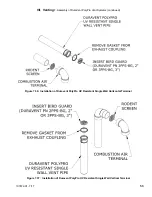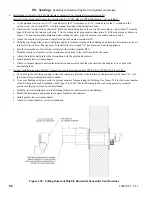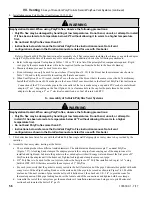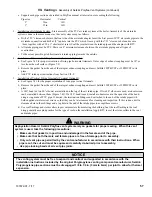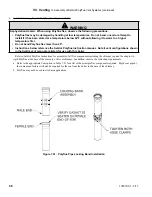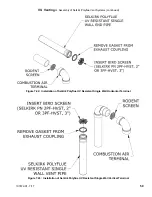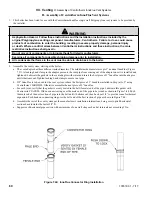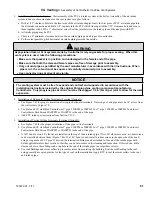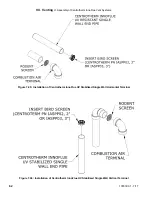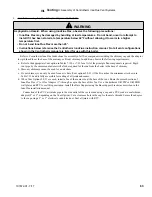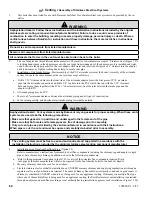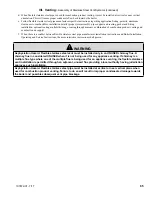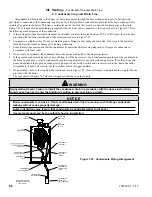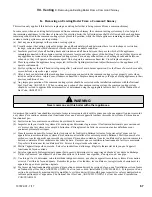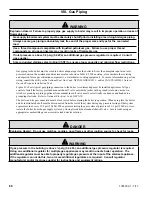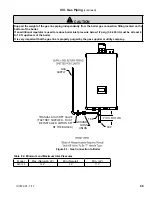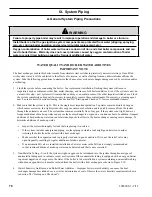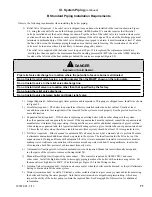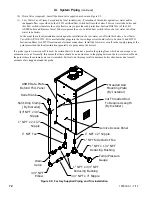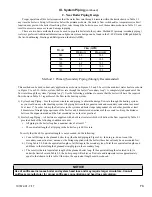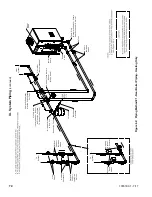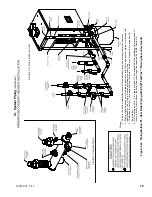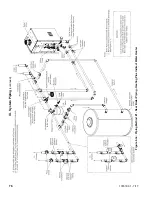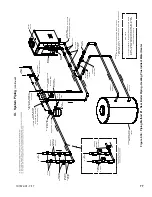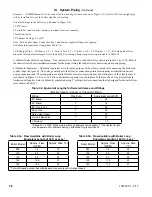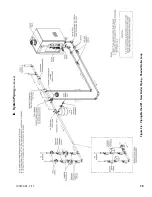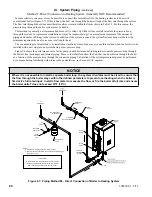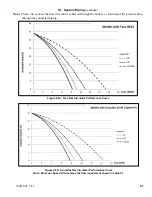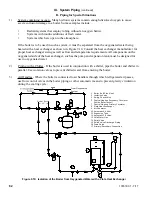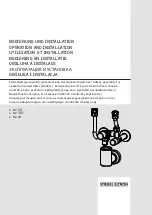
67
107672-01- 7/17
K. Removing an Existing Boiler From a Common Chimney
This section only applies if this boiler is replacing an existing boiler that is being removed from a common chimney.
In some cases, when an existing boiler is removed from a common chimney, the common venting system may be too large for
the remaining appliances. At the time of removal of an existing boiler, the following steps shall be followed with each appliance
remaining connected to the common venting system placed in operation, while the other appliances remaining connected to the
common venting system are not in operation.
(a) Seal any unused openings in the common venting system.
(b) Visually inspect the venting system for proper size and horizontal pitch and determine there is no blockage or restriction,
leakage, corrosion and other deficiencies which could cause an unsafe condition.
(c) Insofar as practical, close all building doors and windows and all doors between the space in which all the appliances
remaining connected to the common venting system are located and other spaces of the building. Turn on clothes dryers and
any appliance not connected to the common venting system. Turn on any exhaust fans, such as range hoods and bathroom
exhausts, so they will operate at maximum speed. Do not operate a summer exhaust fan. Close fireplace dampers.
(d) Place in operation the appliance being inspected. Follow the lighting instructions. Adjust thermostat so the appliance will
operate continuously.
(e)
Test for spillage at the draft hood relief opening after 5 minutes of main burner operation. Use the flame of a match or candle,
or smoke from a cigarette, cigar, or pipe.
(f) After it has been determined that each appliance remaining connected to the common venting system properly vents when
tested as outlined above, return doors, windows, exhaust fans, fireplace dampers and any other gas-burning appliances to their
previous condition of use.
(g) Any improper operation of the common venting system should be corrected so the installation conforms with the National
Fuel Gas Code, ANSI Z223.1. When re-sizing any portion of the common venting system, the common venting system
should be re sized to approach the minimum size as determined using the appropriate tables in Part 11 of the National Fuel
Gas Code, ANSI Z223.1.
VII. Venting
K. Removing an Existing Boiler From a Common Chimney
Warning
Never common vent this boiler with other appliances.
Au moment du retrait d’une chaudière existante, les mesures suivantes doivent être prises pour chaque appareil toujours raccordé
au système d’evacuation commun et qui fonctionne alors que d’autres appareils toujours raccordés au système d’évacuation ne
fonctionnent pas:
(a) Sceller toutes les ouvertures non utilisées du système d’évacuation.
(b) Inspecter de façon visuelle le système d’évcuation pour déterminer la grosseur et l’inclinaison horizontale qui conviennent
et s’assurer que le système est exempt d’obstruction, d’étranglement, de fuite, de corrosion et autres défaillances qui
pourraient présenter des risques.
(c) Dans la mesure du possible, fermer toutes les portes et les fenêtres du bâtiment et toutes les portes entre l’espace où les
appareils toujours raccordés au système d’évacuation sont installés et les autres espaces du bâtiment. Mettre en marche les
sécheuses, tous les appareils non raccordés au système d’évacuation commun et tous les ventilateurs d’extraction comme les
hottes de cuisinière et les ventilateurs des salles de bain. S’assurer que ces ventilateurs fonctionnent à la vitesse maximale.
Ne pas faire fonctionner les ventilateurs d’été. Fermer les registres des cheminées.
(d) Mettre l’appareil inspecté en marche. Suivre les instructions d’allumage. Régler le thermostat de façon que l’appareil
fonctionne de façon continue.
(e) Faire fonctionner le brùleur principal pendant 5 min ensuite, déterminer si le coupe-tirage déborde à l’ouverture de décharge.
Utiliser la flamme d’une allumette ou d’une chandelle ou la fumée d’une cigarette, d’un cigare ou d’une pipe.
(f) Une fois qu’il a été déterminé, selon la méthode indiquée ci-dessus, que chaque appareil raccordé au système d’évacuation
est mis à l’air libre de façon adéquate. Remettre les portes et les fenêtres, les ventilateurs, les registres de cheminées et les
appareils au gaz à leur position originale.
(g) Tout mauvais fonctionnement du système d’évacuation commun devrat être corrigé de façon que l’installation soit conforme
au National Fuel Gas Code, ANSI Z223.1/NFPA 54 et (ou) aux codes d’installation CAN/CSA-B149.1. Si la grosseur d’une
section du système d’évacuation doit être modifiée, le système devrait être modifié pour respecter les valeurs minimales des
tableaux pertinents de l’appendice F du National Fuel Gas Code, ANSI Z223.1/NFPA 54 et (ou) des codes d’installation
CAN/CSA-B149.1.
Summary of Contents for K2WT-080B
Page 83: ...83 107672 01 7 17 PAGE LEFT INTENTIONALLY BLANK...
Page 89: ...89 107672 01 7 17 X Wiring continued Figure 10 5 Internal Ladder Diagram...
Page 90: ...90 107672 01 7 17 X Wiring continued...
Page 91: ...91 107672 01 7 17 Figure 10 6 Internal Wiring Connections Diagram X Wiring continued...
Page 102: ...102 107672 01 7 17 Lighting and Operating Instructions XI Start Up and Checkout continued...
Page 147: ...147 107672 01 7 17 XV Service Parts continued...
Page 151: ...151 107672 01 7 17 XV Service Parts continued...
Page 153: ...153 107672 01 7 17 XV Service Parts continued 85 86 91 95...
Page 162: ...162 107672 01 7 17...
Page 163: ...163 107672 01 7 17...
Page 164: ...164 107672 01 7 17...
Page 165: ...165 107672 01 7 17...
Page 166: ...166 107672 01 7 17...
Page 167: ...167 107672 01 7 17...

